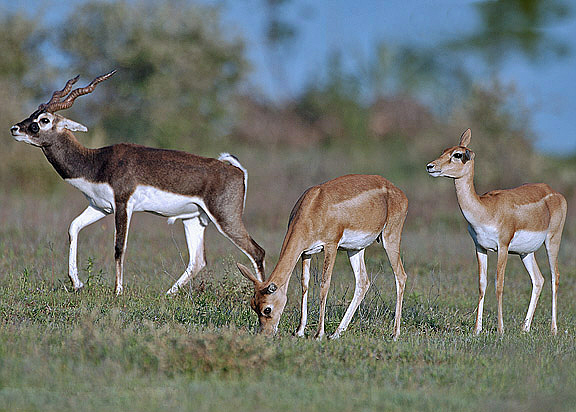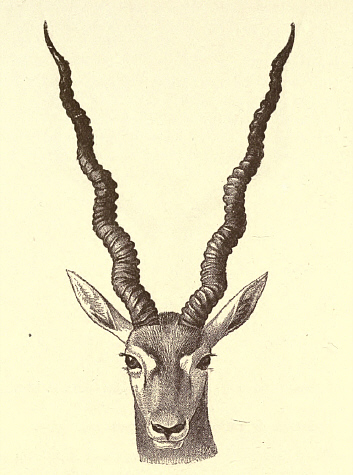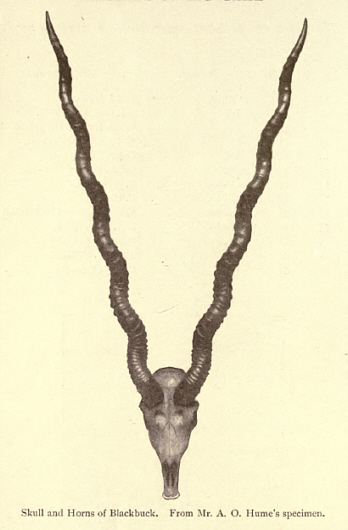

Zitierweise / cite as:
Carakasaṃhitā: Ausgewählte Texte aus der Carakasaṃhitā / übersetzt und erläutert von Alois Payer <1944 - >. -- Anhang B: Tierbeschreibungen. -- Antilope cervicapra. -- Fassung vom 2007-09-11. -- URL: http://www.payer.de/ayurveda/tiere/antilope_cervicapra.htm
Erstmals publiziert:
Überarbeitungen:
Anlass: Lehrveranstaltung SS 2007
©opyright: Dieser Text steht der Allgemeinheit zur Verfügung. Eine Verwertung in Publikationen, die über übliche Zitate hinausgeht, bedarf der ausdrücklichen Genehmigung des Verfassers
Dieser Text ist Teil der Abteilung Sanskrit von Tüpfli's Global Village Library
WARNUNG: dies ist der Versuch einer
Übersetzung und Interpretation eines altindischen Textes. Es ist keine
medizinische Anleitung. Vor dem Gebrauch aller hier genannten Heilmittel wird
darum ausdrücklich gewarnt. Nur ein erfahrener, gut ausgebildeter ayurvedischer
Arzt kann Verschreibungen und Behandlungen machen!
Falls Sie die diakritischen Zeichen nicht dargestellt bekommen, installieren Sie eine Schrift mit Diakritika wie z.B. Tahoma.
Verwendete und zitierte Werke siehe: http://www.payer.de/ayurveda/caraka000b.htm

Abb.: Antilope cervicapra - Blackbuck -
Hirschziegenantilope, Nannaj bei Solapur (सोलापूर), Maharashtra (महाराष्ट्र)
[Bildquelle: Wikipedia]

Abb.: Kopf und Geweih von
Antilope cervicapra
[Bildquelle: Ward, 1903]

Abb.: Geweih von
Antilope cervicapra
[Bildquelle: Ward, 1903]
Lydekker:
"THE BLACK-BUCK.
Genus Antilope.
The handsomely-coloured black-buck or Indian antelope (Antilope cervicapra) is the sole representative of its genus, and at the same time the last member of the present group. The black-buck stands about 32 inches at the shoulder, and has a short and compressed tail, large glands, with a linear aperture below the eyes, tufts of hair on the knees, and small but distinct lateral hoofs. The horns of the bucks rise close together, and are cylindrical, divergent, and spiral, with complete blunt rings throughout their length. The number of turns in the spiral of the horns varies from less than three to as
many as five ; and there is great individual variation in regard to the degree of divergence of the horns. The usual length of horns varies from 16 to 20 inches in a straight line, and in Peninsular India the length seldom exceeds 22 inches ; but in Rajputana and Harriana the horns are longer, and have been known to attain a length of 28¾ inches. Does and young bucks are yellowish fawn-colour above and on the outer sides of the limbs, and white on the under-parts ; the two colours are sharply defined, and just above the line of division there is a distinct pale streak. Save for a rufous patch on the nape of the neck, the old bucks are blackish brown above, and also on the sides of the neck and the whole of the face, with the exception of a white ring round each eye. In very old individuals the blackish brown becomes almost completely black. Occasionally does are met with having small recurved horns.
The black-buck is an inhabitant of open plains from the foot of the Himalaya nearly to Cape Comorin, and from the Punjab to Lower Assam ; and is most abundant in the North-West Provinces, Rajputana, and portions of the Deccan. It frequents either grassy districts or cultivated lands, and is generally found in herds, which may comprise hundreds or even thousands of individuals, but more usually number from ten to thirty, or even fifty does, accompanied by a single old buck. Mr. Blanford states that frequently "two or three younger bucks, coloured like the does, remain with the latter, but these young males are sometimes driven away by older bucks, and form separate herds. This antelope never enters forest nor high grass, and is but rarely seen amongst bushes. When not much pursued or fired at, it will often allow men to come in the open within about one hundred and fifty yards, sometimes nearer."Carts and natives can approach still closer. The black-buck feeds at all hours, although it generally rests during the middle of the day. In certain districts, where there is no fresh water except in deep wells, it is certain that these animals never drink ; but several observers have proved that in other places they, at least occasionally, drink freely. Like the springbok, the black-buck frequently leaps high in the air when running. The speed and endurance of these animals are well known ; and it is but very seldom that they are pulled down on good ground by greyhounds. In heavy sand, or on soft ground during the rains, they are, however, easily overtaken by good dogs ; and wounded buck may be ridden down. An account of black-buck coursing with the hunting-leopard will be found on p. 445 of the first volume ; and antelope-stalking is a favourite Indian sport.
Young fawns are generally concealed by the does in long grass. The bucks utter a short grunt, and the does a kind of hissing sound when alarmed. During the pairing-season the bucks engage in frequent combats among themselves. When taken young, the black-buck can be easily tamed, but the males are apt to be dangerous at certain seasons."
[Quelle: Lydekker, Richard <1849-1915>: The royal natural history / edited by Richard Lydekker ; with preface by P.L. Sclate. -- London ; New York : F. Warne, 1893-96. -- 6 Bde. : ill. (some col.) ; 26 cm. -- Bd. 2. -- S. 300 - 302. -- Online: http://www.archive.org/details/royalnaturalhist02lyderich. -- Zugriff am 2007-09-27]
Blanford:
"Genus ANTILOPE, Pallas (1767).
Size moderate. Tail short, compressed. Large suborbital glands with a linear opening. Interdigital glands large in all feet. Inguinal glands large. No muffle, Mammas 2. Hoofs pointed. A tuft of long hair on each knee (carpus).
Skull with prominent orbits ; the frontal profile rounded off into the parietal, which meets the occipital at an obtuse angle. Supraorbital foramina of frontals large, a small lachrymal fissure and large lachrymal fossa. Horns in the male only, arising near together, cylindrical, spiral, diverging, ringed throughout, the rings subdistant, closer together near the skull, blunt, extending all round the horns.
A single species peculiar to India. The horn-cores are found fossil in the Pleistocene Jumna beds.
Antilope cervicapra. The Indian Antelope or black Buck.
Capra cervicapra, L. Syst. Nat. i, p. 96 (1766).
Antilope cervicapra, Pallas, Spic. Zool. i, p. 19, pls. i, ii (1767) ; Gray & Hardw. III. Ind. Zool. i, pis. xii, xiii ; Bennett, P. Z. S. 1836, p. 34; Elliot, Mad. Jour. L. S. x, p. 222; Hutton, J. A. S. B. XT, p. 150 ; Stanford, J. A. 8. B. xliv, pt. 2, p. 18 ; Ball, P. A. S. B. 1877, p. 171 ; W. Sclater, Cat. p. 162.
Antilope bezoartica, Gray, P. Z. S. 1850, p. 117; Blyth, Cat. p. 171; Jerdon, Mam. p. 275 ; Blanford, J. A. S. B. xxxvi, pt. 2, p. 196 ; Stoliczka, J. A. S. B. xli, pt. 2, p. 229.Ena (male) , Harina, Mirga, Sanscr. ; Haran, Harna (male) , Harni (fem.) , Kalwit (fem.), Mrig, H. ; Kala (male) , Goria (fem.) , Tirhoot ; Kālsar (male) , Baoti (fem.) , Behar
The horns vary in divergence and in closeness of spiral ; in some the points are not more than 7 inches apart, in others as much as 20, irrespective of length ; the turns of the spiral in adults vary from less than 3 to 5. Horned females are occasionally, but very rarely, met with ; I once saw one, near Nagpur. In these the horns curve back, more or less, from the head.
Colour of does and young bucks yellowish-fawn above and on the outside of the limbs, lower parts white, the two colours sharply divided; a distinct pale lateral band a little above the line of division. Old bucks are blackish brown above, becoming almost black in very old animals, except on the nape, which remains brownish rufous, whilst the sides and front of the neck, and also the face except a white area round each eye, are blackish brown. The pale lateral band disappears in old males.
Dimensions. Height at shoulder about 32 inches ; length of head and body 4 feet, tail 7 inches, weight about 90 lb. Basal length of a male skull 8.6 ; breadth across orbits 4.1. Horns of adults are usually 16 to 20 inches long, measured in front straight from base to tip ; in the Peninsula they rarely exceed 22 inches. The longest horns are met with in Rajputana and Hurriana, where 28-75 inches has been recorded. Largest observed girth at base 6.25.
Distribution. India from the base of the Himalayas to the neighbourhood of Cape Comorin (the southernmost locality known to me is Point Calimere), and from the Punjab to Lower Assam, in open plains, not in Ceylon nor east of the Bay of Bengal. Not found on hills nor in thickly wooded tracts, and wanting throughout theMalabar coast south of the neighbourhood of Surat. The statement that this antelope is not found in Lower Bengal is not quite correct ; none are found in the swampy Gangetic delta, but many exist on the plains near the coast in Midnapore (I have shot them near Contai), as they also do in Orissa. Antelopes are most abundant in the North-west Provinces, Rajputana, and parts of the Deccan, but are locally distributed and keep to particular tracts.
Habits. Open plains of short grass, level or undulating, and cultivated land are the usual haunts of the Indian antelope, which is generally found in herds ; these are sometimes extremely numerous, and comprise occasionally several thousand animals of both sexes and all ages ; but more often small herds of does, generally 10 to 30 in number, but sometimes as many as 50, are met with, attended by a single black buck, which does not always accompany the females. Very often two or three younger bucks coloured like the does remain with the latter ; but these young males are sometimes driven away by older bucks, and form separate herds. This antelope never enters forest nor high grass, and is but rarely seen amongst bushes. Where not much pursued or fired at, it will often allow men to come in the open within about 150 yards, sometimes nearer. Of country-carts, bullocks, or coolies carrying loads, it often takes but little notice at half that distance.
Like most animals of open plains, the Indian antelope appears to have no particular hours for feeding, though it generally rests in the middle of the day. I cannot say it never drinks, for I have been assured by several people that it does, but I cannot help suspecting that its visits to the neighbourhood of water are for the purpose of feeding on the fresh grass to be found there. That it can exist without ever drinking is proved by its abundance between the salt Chilka Lake in Orissa and the sea, on a spit of sand 30 miles long, where the only drinking-water is from a well.
The speed and endurance of the antelope are well known. Col. W. Campbell, in ' My Indian Journal,' relates how his brother, on a fast Arab horse, once ran down and speared a buck near Dharwar, but the feat has not often been repeated. Wounded antelope are often ridden down, but sometimes require a good horse to catch them. I was once completely beaten on fair ground by a buck with a broken fore-leg, but I was on a horse that, although speedy, had but little endurance. Jerdon says : "Very rarely good greyhounds have pulled down this antelope unwounded on ordinary ground ; but there are at least three localities where this coursing used to be practised successfully." The localities were on heavy sand at Pooree in Orissa and at Sirsa in the Punjab, and on fine pasture land at Point Calimere, south of Trichinopoly. Jerdon adds that on soft ground, during the rains, antelope are easily caught by good dogs. He also says : "Greyhounds are very keen after a wounded antelope, and occasionally get savage and fight over it when pulled down." This is confirmed by McMaster.
The Indian antelope, like the South-African springbok (Gazella euchore), has the habit of occasionally springing into the air, all the members of a herd generally bounding, one after the other. This is done, as Sir W. Elliot has shown, before they are much frightened, and when the herd is first moving off. When at speed the gallop is like that of any other animal. Occasionally these antelopes conceal themselves in grass or cultivation, and wounded animals not unfrequently hide. Young fawns, too, are generally concealed by the mothers. The only sound I have ever heard the buck utter is a peculiar grunt that he makes when excited ; the females have a hissing alarm note, according to Forsyth. Like most other Indian antelopes, they deposit their dung repeatedly on the same spot.
Like most antelopes, and indeed ruminants in general, this species is easily tamed, if captured young. Many used to be taken in nets or in snares, and one native method of capturing the bucks was to send a tame black buck with nooses attached to his horns into the herd, and to seize the wild one when entangled in the fight which inevitably ensued. The bucks are greatly given to fighting.
"The rutting-season," says Mr. Elliot, "commences about February or March, but fawns are seen of all ages at every season. During the spring months the buck often separates a particular doe from the herd, and will not suffer her to join it again, cutting her off and intercepting every attempt to mingle with the rest. The two are often found alone also, but on being followed always rejoin the herd."
A buck may frequently be seen chasing one particular doe. I cannot find the period of' gestation recorded.
The flesh of the Indian antelope is excellent."
[Quelle: Blanford, W. T. <1832 – 1905>: Mammalia. -- 1888 - 1891. -- (Fauna of British India including Ceylon and Burma). -- S. 521 - 524. -- Online: http://www.archive.org/details/mammalia00blaniala. -- Zugriff am 2007-09-06]